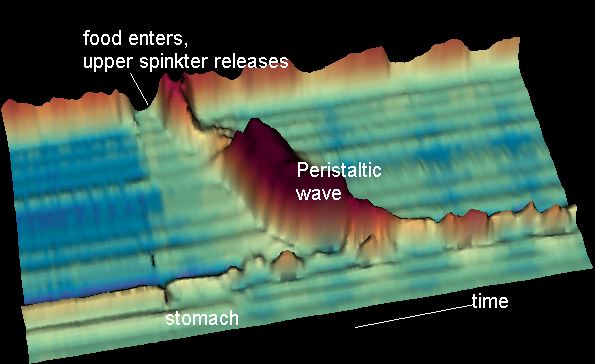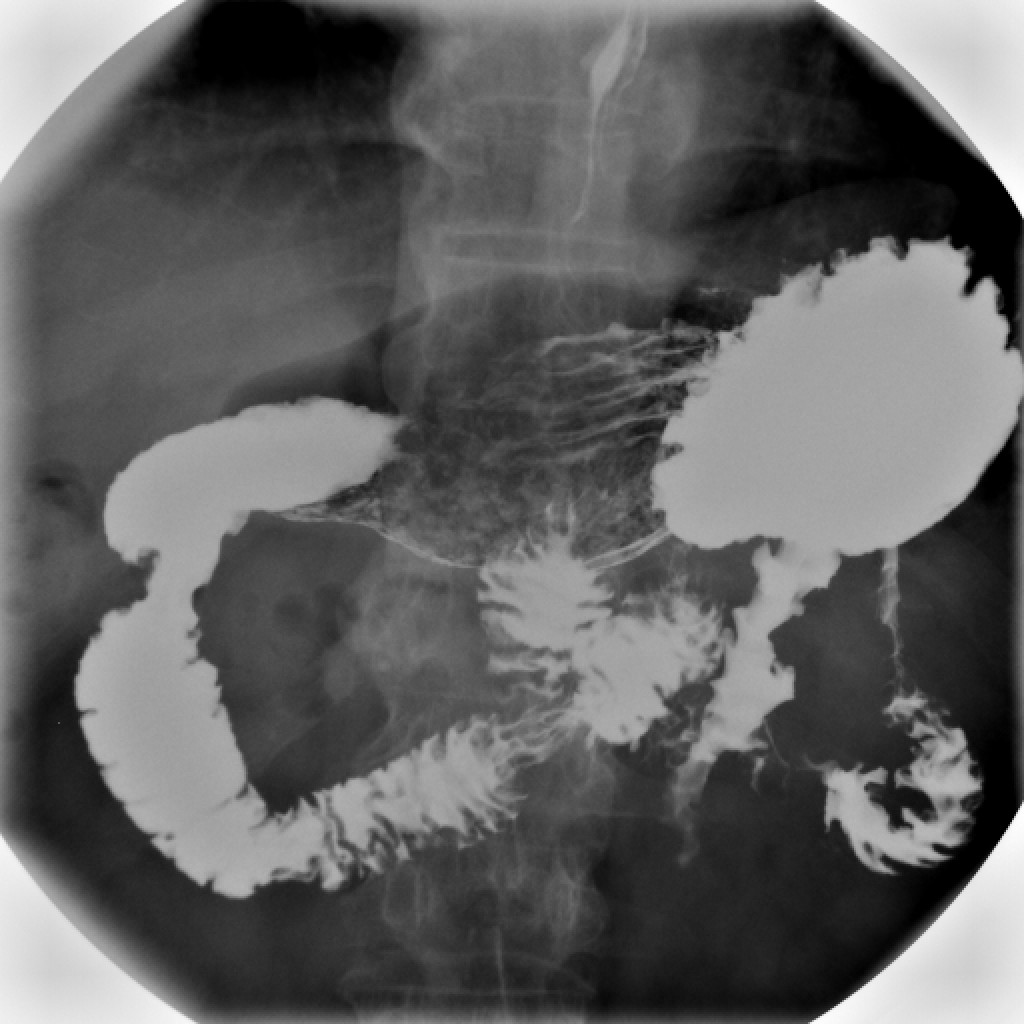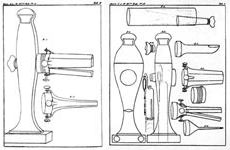|
Achalasia
Esophageal achalasia, often referred to simply as achalasia, is a failure of smooth muscle fibers to relax, which can cause the lower esophageal sphincter to remain closed. Without a modifier, "achalasia" usually refers to achalasia of the esophagus. Achalasia can happen at various points along the human gastrointestinal tract, gastrointestinal tract; achalasia of the rectum, for instance, may occur in Hirschsprung's disease. The lower esophageal sphincter is a muscle between the esophagus and stomach that opens when food comes in. It closes to avoid Gastric acid, stomach acids from coming back up. A fully understood cause to the disease is unknown, as are factors that increase the risk of its appearance. Suggestions of a Genetic disorder, genetically transmittable form of achalasia exist, but this is neither fully understood, nor agreed upon. Esophageal achalasia is an esophageal motility disorder involving the smooth muscle cell, smooth muscle layer of the esophagus and the lowe ... [...More Info...] [...Related Items...] OR: [Wikipedia] [Google] [Baidu] |
Per-oral Endoscopic Myotomy
The per-oral endoscopic myotomy, or POEM, is a minimally invasive surgical procedure for the treatment of achalasia wherein the inner circular muscle layer of the lower esophageal sphincter is divided through a submucosal tunnel. This enables food and liquids to pass into the stomach, a process that is impaired in achalasia. The tunnel is created, and the myotomy performed, using a flexible endoscope, meaning the entire procedure can be done without external incisions. History & development Achalasia, a disease characterized by impaired esophageal peristalsis and failure of the lower esophageal sphincter to relax, has classically been treated endoscopically by dilation or botulinum toxin injection of the sphincter or surgically by a myotomy in which the muscle fibers are cut through a thoracic or abdominal approach. The principles of an endoscopic surgical myotomy were developed in the 2000s on animal models by Pankaj "Jay" Pasricha at University of Texas Medical Branch. The first ... [...More Info...] [...Related Items...] OR: [Wikipedia] [Google] [Baidu] |
Heller Myotomy
Heller myotomy is a surgical procedure in which the muscles of the cardia ( lower esophageal sphincter or LES) are cut, allowing food and liquids to pass to the stomach. It is used to treat achalasia, a disorder in which the lower esophageal sphincter fails to relax properly, making it difficult for food and liquids to reach the stomach. History and development It was first performed by Ernst Heller (1877–1964) in 1913. Then and until recently, this surgery was performed using an open procedure, either through the chest ( thoracotomy) or through the abdomen (laparotomy). However, open procedures involve greater recovery times. Modern Heller myotomy is normally performed using minimally invasive laparoscopic techniques, which minimize risks and speeds recovery significantly. The 100th anniversary of Heller's description of the surgical treatment of patients with achalasia was celebrated in 2014. Procedure During the procedure, the patient is put under general anaesthesia. F ... [...More Info...] [...Related Items...] OR: [Wikipedia] [Google] [Baidu] |
Dysphagia
Dysphagia is difficulty in swallowing. Although classified under " symptoms and signs" in ICD-10, in some contexts it is classified as a condition in its own right. It may be a sensation that suggests difficulty in the passage of solids or liquids from the mouth to the stomach, a lack of pharyngeal sensation or various other inadequacies of the swallowing mechanism. Dysphagia is distinguished from other symptoms including odynophagia, which is defined as painful swallowing, and globus, which is the sensation of a lump in the throat. A person can have dysphagia without odynophagia (dysfunction without pain), odynophagia without dysphagia (pain without dysfunction) or both together. A psychogenic dysphagia is known as phagophobia. Classification Dysphagia is classified into the following major types: # Oropharyngeal dysphagia # Esophageal and obstructive dysphagia # Neuromuscular symptom complexes # Functional dysphagia is defined in some patients as having no organic c ... [...More Info...] [...Related Items...] OR: [Wikipedia] [Google] [Baidu] |
Botulinum Toxin
Botulinum toxin, or botulinum neurotoxin (commonly called botox), is a neurotoxic protein produced by the bacterium ''Clostridium botulinum'' and related species. It prevents the release of the neurotransmitter acetylcholine from axon endings at the neuromuscular junction, thus causing flaccid paralysis. The toxin causes the disease botulism. The toxin is also used commercially for medical and cosmetic purposes. Botulinum toxin is an acetylcholine release inhibitor and a neuromuscular blocking agent. The seven main types of botulinum toxin are named types A to G (A, B, C1, C2, D, E, F and G). New types are occasionally found. Types A and B are capable of causing disease in humans, and are also used commercially and medically. Types C–G are less common; types E and F can cause disease in humans, while the other types cause disease in other animals. Botulinum toxins are among the most potent toxins known to science. Intoxication can occur naturally as a result of eithe ... [...More Info...] [...Related Items...] OR: [Wikipedia] [Google] [Baidu] |
Esophageal Motility Disorder
An esophageal motility disorder (EMD) is any medical disorder resulting from dysfunction of the coordinated movement of esophagus, which causes dysphagia (i.e. difficulty in swallowing, regurgitation of food). Primary motility disorders are: * Achalasia * Diffuse esophageal spasm * Nutcracker esophagus * Hypertensive lower esophageal sphincter An esophageal motility disorder can also be secondary to other diseases. For example, it may be a result of CREST syndrome, referring to the five main features: calcinosis, Raynaud syndrome, esophageal dysmotility, sclerodactyly and telangiectasia.Winterbauer RH (1964). "Multiple telangiectasia, Raynaud's phenomenon, sclerodactyly, and subcutaneous calcinosis: a syndrome mimicking hereditary hemorrhagic telangiectasia". Bulletin of the Johns Hopkins Hospital 114: 31–83. . Symptoms The most common symptom of esophageal motility disorders is dysphagia. Compared to causes of mechanical obstruction, which usually coincide with diffi ... [...More Info...] [...Related Items...] OR: [Wikipedia] [Google] [Baidu] |
Candidiasis
Candidiasis is a fungal infection due to any species of the genus '' Candida'' (a yeast). When it affects the mouth, in some countries it is commonly called thrush. Signs and symptoms include white patches on the tongue or other areas of the mouth and throat. Other symptoms may include soreness and problems swallowing. When it affects the vagina, it may be referred to as a yeast infection or thrush. Signs and symptoms include genital itching, burning, and sometimes a white "cottage cheese-like" discharge from the vagina. Yeast infections of the penis are less common and typically present with an itchy rash. Very rarely, yeast infections may become invasive, spreading to other parts of the body. This may result in fevers, among other symptoms. Finally, candiasis of the esophagus is an important risk factor for contracting esophageal cancer in individuals with achalasia. More than 20 types of ''Candida'' may cause infection with '' Candida albicans'' being the most common. Inf ... [...More Info...] [...Related Items...] OR: [Wikipedia] [Google] [Baidu] |
Peristalsis
Peristalsis ( , ) is a type of intestinal motility, characterized by symmetry in biology#Radial symmetry, radially symmetrical contraction and relaxation of muscles that propagate in a wave down a tube, in an wikt:anterograde, anterograde direction. Peristalsis is progression of coordinated contraction of involuntary circular muscles, which is preceded by a simultaneous contraction of the longitudinal muscle and relaxation of the circular muscle in the lining of the gut. In much of a digestive tract, such as the human gastrointestinal tract, smooth muscle tissue contracts in sequence to produce a peristaltic wave, which propels a ball of food (called a bolus (digestion), bolus before being transformed into chyme in the stomach) along the tract. The peristaltic movement comprises relaxation of circular smooth muscles, then their contraction behind the chewed material to keep it from moving backward, then longitudinal contraction to push it forward. Earthworms use a similar mec ... [...More Info...] [...Related Items...] OR: [Wikipedia] [Google] [Baidu] |
Esophageal Cancer
Esophageal cancer (American English) or oesophageal cancer (British English) is cancer arising from the esophagus—the food pipe that runs between the throat and the stomach. Symptoms often include dysphagia, difficulty in swallowing and weight loss. Other symptoms may include odynophagia, pain when swallowing, a hoarseness, hoarse voice, Lymphadenopathy, enlarged lymph nodes ("glands") around the clavicle, collarbone, a dry cough, and possibly hemoptysis, coughing up or hematemesis, vomiting blood. The two main Histopathology, sub-types of the disease are esophageal squamous-cell carcinoma (often abbreviated to ESCC), which is more common in the developing world, and esophageal adenocarcinoma (EAC), which is more common in the developed world. A number of less common types also occur. Squamous-cell carcinoma arises from the squamous epithelium, epithelial cells that line the esophagus. Adenocarcinoma arises from glandular cells present in the lower third of the esophagus, ofte ... [...More Info...] [...Related Items...] OR: [Wikipedia] [Google] [Baidu] |
Barium Swallow
An upper gastrointestinal series, also called a barium swallow, barium study, or barium meal, is a series of radiographs used to examine the gastrointestinal tract for abnormalities. A contrast medium, usually a radiocontrast agent such as barium sulfate mixed with water, is ingested or instilled into the gastrointestinal tract, and X-rays are used to create radiographs of the regions of interest. The barium enhances the visibility of the relevant parts of the gastrointestinal tract by coating the inside wall of the tract and appearing white on the film. This in combination with other plain radiographs allows for the imaging of parts of the upper gastrointestinal tract such as the pharynx, larynx, esophagus, stomach, and small intestine such that the inside wall lining, size, shape, contour, and patency are visible to the examiner. With fluoroscopy, it is also possible to visualize the functional movement of examined organs such as swallowing, peristalsis, or sphincter closure. De ... [...More Info...] [...Related Items...] OR: [Wikipedia] [Google] [Baidu] |
Esophageal Manometry
An esophageal motility study (EMS) or esophageal manometry is a test to assess motor function of the upper esophageal sphincter (UES), esophageal body and lower esophageal sphincter (LES). Indications An EMS is typically done to evaluate suspected disorders of motility or peristalsis of the esophagus. These include achalasia, diffuse esophageal spasm, nutcracker esophagus and hypertensive lower esophageal sphincter. These disorders typically present with dysphagia, or difficulty swallowing, usually to both solids and liquids even initially. Other patients with spasm disorders may have the test done to diagnose chest pain thought not to be of cardiac cause. The test is not useful for anatomical disorders of the esophagus (that is, disorders that distort the anatomy of the esophagus), such as peptic strictures and esophageal cancer. Procedure A technician places a catheter into the nose and then guides it into the stomach. Once placed in the stomach lining, the catheter is s ... [...More Info...] [...Related Items...] OR: [Wikipedia] [Google] [Baidu] |
Regurgitation (digestion)
Regurgitation is the expulsion of material from the pharynx, or esophagus, usually characterized by the presence of undigested food or blood. Regurgitation is used by a number of species to feed their young. This is typically in circumstances where the young are at a fixed location and a parent must forage or hunt for food, especially under circumstances where the carriage of small prey would be subject to robbing by other predators or the whole prey is larger than can be carried to a den or nest. Some bird species also occasionally regurgitate Pellet (ornithology), pellets of indigestible matter such as bones and feathers. It is in most animals a normal and voluntary process unlike the complex vomiting reflex in response to toxins. Humans Regurgitation can be voluntary or involuntary for humans. It can occur alongside gastroesophageal reflux disease (GERD), acid reflux and some anatomical abnormalities. In infants however, regurgitation – or spitting up – is quite comm ... [...More Info...] [...Related Items...] OR: [Wikipedia] [Google] [Baidu] |
Gastroenterology
Gastroenterology (from the Greek gastḗr- "belly", -énteron "intestine", and -logía "study of") is the branch of medicine focused on the digestive system and its disorders. The digestive system consists of the gastrointestinal tract, sometimes referred to as the ''GI tract,'' which includes the esophagus, stomach, small intestine and large intestine as well as the accessory organs of digestion which include the pancreas, gallbladder, and liver. The digestive system functions to move material through the GI tract via peristalsis, break down that material via digestion, absorb nutrients for use throughout the body, and remove waste from the body via defecation. Physicians who specialize in the medical specialty of gastroenterology are called gastroenterologists or sometimes ''GI doctors''. Some of the most common conditions managed by gastroenterologists include gastroesophageal reflux disease, gastrointestinal bleeding, irritable bowel syndrome, inflammatory bowel disease (IBD ... [...More Info...] [...Related Items...] OR: [Wikipedia] [Google] [Baidu] |






